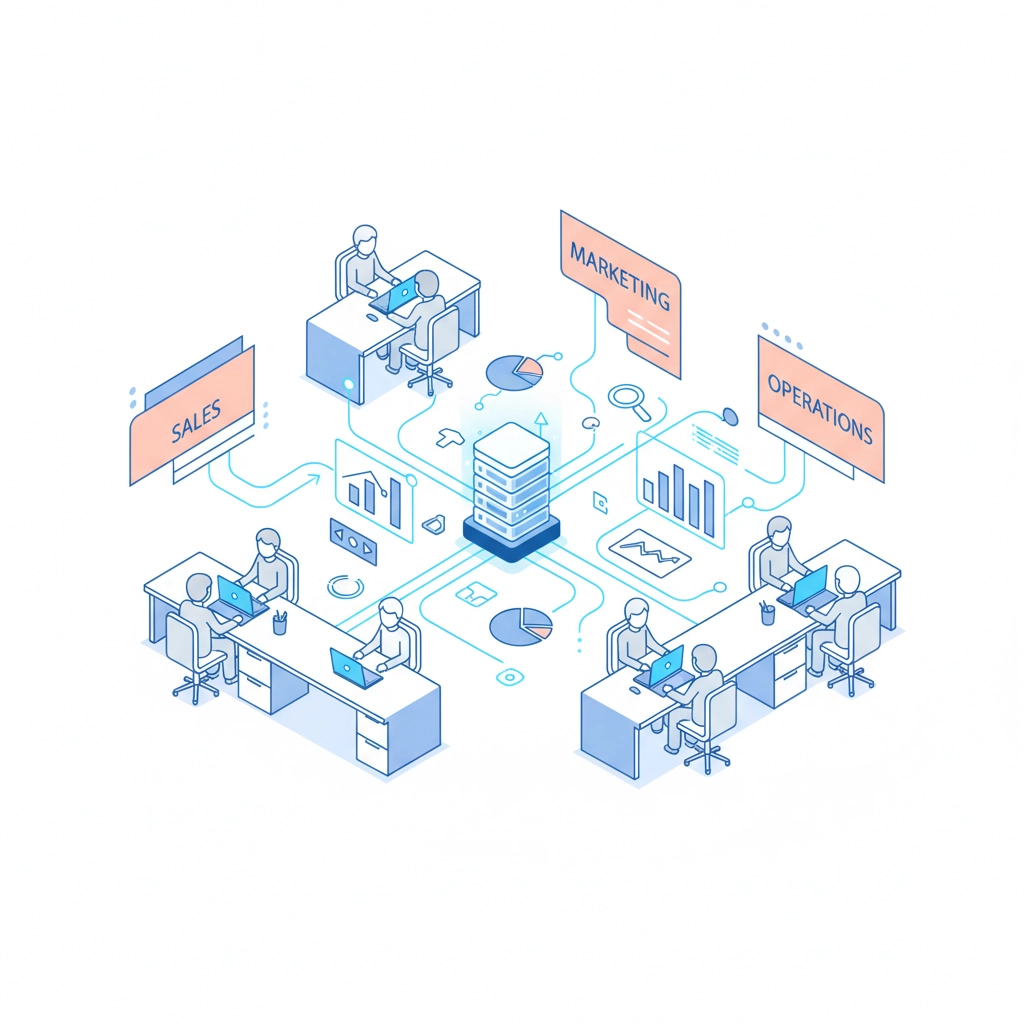Data isn’t just for the big players anymore. In 2025, small and medium enterprises have access to the same sophisticated analytics tools that once cost millions and required massive IT departments. The difference now? It’s not about having the biggest budget: it’s about knowing what to do with the information you’ve got.
If you’re running an SME and wondering how to compete with larger rivals, the answer might be sitting in your systems right now. Let’s explore how you can turn your business data into a competitive weapon.
Why Should SME Leaders Care About Data in 2025?
The playing field has fundamentally changed. Advanced analytics tools and artificial intelligence have become accessible to businesses of all sizes, meaning your local competitor down the road could be using the same predictive models as multinational corporations.
The businesses thriving in 2025 aren’t necessarily the ones with the most data: they’re the ones making the smartest decisions with what they have. Real-time visibility into market dynamics, customer behaviour patterns, and operational inefficiencies can transform how quickly you respond to opportunities and threats.
Consider this: whilst your competitors are still relying on monthly reports and gut feelings, you could be making data-driven decisions daily. That’s not just an advantage: it’s a complete shift in how you operate.

What Data Should SMEs Focus on First?
Starting your data journey can feel overwhelming, but successful SMEs focus on three core areas that deliver immediate competitive advantages.
Customer behaviour data sits at the top of this list. Understanding when your customers buy, what triggers their purchases, and how they interact with your business reveals patterns that can dramatically improve your operations. One quick-service restaurant chain saw a 5% increase in group sales simply by using data to understand their workforce better and improve customer satisfaction.
Sales and revenue patterns come next. Real-time sales tracking, deal progression analysis, and pipeline forecasting help you spot opportunities before competitors even know they exist. This isn’t about complex algorithms: it’s about having clear visibility into what’s working and what isn’t.
Operational efficiency metrics round out the essentials. From inventory turnover to staff productivity, these insights help you run leaner whilst maintaining quality. Many SMEs discover they’re wasting resources in areas they never considered.
How Can SMEs Implement Business Intelligence Without Breaking the Bank?
The beauty of modern BI tools is their accessibility. Platforms like Power BI, Tableau, and Google Data Studio offer powerful capabilities at prices that make sense for growing businesses. More importantly, they’re designed for non-technical teams.
Start with interactive dashboards that make insights accessible across your organisation. When your sales team can see real-time performance data, and your operations team understands customer demand patterns, decisions happen faster and more effectively.
The key is implementation. Many SMEs try to build everything at once and get overwhelmed. Instead, focus on one area: perhaps sales performance or customer service metrics: and build from there. Success breeds confidence, and confidence drives adoption.
This is where fractional directors become invaluable. An experienced leader who’s implemented BI systems across multiple businesses can guide your approach, avoiding common pitfalls and ensuring you’re building something sustainable rather than just impressive.
What Role Do AI and Automation Play for SMEs?
Artificial intelligence isn’t science fiction anymore: it’s a practical business tool. SMEs are using AI to automate customer segmentation, predict demand, and optimise scheduling based on historical patterns.
Customer service enhancement represents one of the most immediate wins. By monitoring support tickets and tracking resolution times, you can proactively address issues before they become problems. Your customers notice when you’re consistently ahead of their needs.
Supply chain optimisation offers another quick victory. AI-driven analytics can predict inventory needs, automate reordering, and identify potential supply disruptions before they impact your business. Whilst competitors scramble to respond to shortages, you’re already three steps ahead.
The progression is straightforward: start with basic automation for repetitive tasks, then gradually expand into predictive capabilities. The marketplace for AI tools continues expanding rapidly, with new solutions appearing regularly that don’t require massive infrastructure investments.

How Can Data Improve Customer Relationships?
Customer data reveals opportunities that traditional relationship management misses. By analysing purchasing patterns, you can identify your most valuable customers, understand what drives their loyalty, and spot early warning signs when they might be considering alternatives.
Personalised service becomes possible at scale. When you understand each customer’s preferences, timing, and communication style, every interaction feels tailored rather than generic. This level of attention was once only possible for businesses with dedicated account managers for each client.
Proactive problem-solving sets you apart from reactive competitors. Data can reveal patterns in customer complaints, service requests, or product issues before they become widespread problems. Addressing concerns before customers even realise they have them builds tremendous loyalty.
The competitive advantage here isn’t just better service: it’s demonstrating that you understand your customers better than anyone else in your market.
What Security Considerations Matter for SME Data Strategies?
Data security has evolved from an operational necessity into a competitive differentiator. SMEs that establish robust security protocols and ensure compliance with regulations like GDPR build trust that becomes a significant business asset.
Multi-factor authentication, end-to-end encryption, and regular security audits aren’t just protective measures: they’re trust-building tools. When potential clients or partners see that you take data protection seriously, it influences their decision to work with you.
Compliance capabilities also open doors. Many larger organisations require their suppliers to meet specific data protection standards. By implementing these early, you position yourself for opportunities that competitors might miss.
The investment in proper security pays dividends beyond protection. It demonstrates professionalism and forward-thinking that clients value, especially in data-sensitive industries.
How Do Fractional Directors Accelerate Data Implementation?
Implementing data strategies successfully requires experience that most SMEs don’t have internally. This is where fractional directors from Leadership Services provide tremendous value: they bring expertise from multiple successful implementations without the commitment of a full-time hire.
Strategic planning ensures you’re building something aligned with your business goals rather than just following the latest trends. An experienced director can assess your current capabilities, identify the highest-impact opportunities, and create a realistic implementation timeline.
Vendor selection and implementation management prevents costly mistakes. The marketplace for data tools is vast and complex. Directors who’ve navigated these waters before can guide you to solutions that actually fit your needs and budget.
Change management often determines success or failure. Getting your team comfortable with new tools and processes requires leadership skills that go beyond technical knowledge. Fractional directors excel at building adoption because they’ve seen what works across different organisational cultures.

What Competitive Advantages Can SMEs Expect from Data?
The competitive advantages from strategic data use compound over time. Initially, you might see improvements in response times and decision accuracy. As your capabilities mature, you’ll develop insights that fundamentally change how you approach your market.
Market responsiveness becomes a defining characteristic. Whilst competitors rely on quarterly reviews and annual planning cycles, you’re adjusting tactics based on real-time market signals. This agility allows SMEs to pivot faster than larger organisations.
Resource optimisation improves profitability without reducing quality. Data reveals inefficiencies in everything from staffing schedules to inventory management. Small improvements in multiple areas create significant overall advantages.
Customer intelligence helps you serve existing clients better whilst identifying new opportunities. Understanding customer behaviour patterns at a granular level reveals cross-selling opportunities, retention risks, and market expansion possibilities that competitors miss.
The businesses that invest in these capabilities now will be the ones setting the pace in their markets over the coming years.
Getting Started: Your Data Journey in 2025
The key to success with business data isn’t starting with the most sophisticated tools: it’s starting with clear objectives and building systematically. Focus on solving specific business problems rather than implementing impressive technology.
Begin with your biggest pain points. Whether that’s customer retention, operational efficiency, or sales forecasting, use data to understand the problem before trying to solve it. This approach ensures your investments deliver measurable returns.
Consider bringing in experienced guidance early. The cost of a fractional director is minimal compared to the mistakes they’ll help you avoid and the opportunities they’ll help you capture.
Your competitors are either already using data strategically or they’re falling behind. The question isn’t whether to embrace data-driven decision making: it’s how quickly you can implement it effectively. The SMEs that get this right in 2025 will be the market leaders of tomorrow.


